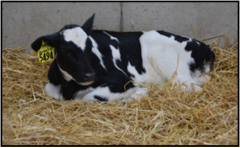Winter Feeding and Management Practices for Dairy Calves
Winter Feeding and Management Practices for Dairy Calves

Dairy calves are very sensitive to the colder, fall and winter temperatures and, as such, feeding and management practices need to be tweaked to help calves deal with these cooler temperatures. Dairy calves are born with only a modest insulation afforded by their hair coat and very little body fat (only 3 to 4% body fat) to provide energy needed to stay warm. As outside temperatures drop below a calf’s comfort zone, known as the thermoneutral zone, more energy is used by the dairy calf to stay warm and, as such, her maintenance needs increase. If her energy intake remains constant, less energy is available to support her immune system, a necessary component in disease prevention, and also growth, consequently resulting in calves growing at a slower pace. Newborn calves within the first 3 weeks of life are the most sensitive to the colder temperatures and have a lower critical temperature of 60ºF. As temperatures drop below 60ºF, newborn calves become cold stressed. After 3 weeks of age, this lower critical temperature decreases to 40 to 50ºF. Tweaking feeding and management practices during this time of year are important to maintain the health and growth of these young calves. These practices include:
- Dry newborn calf hair coats and provide 4 quarts of colostrum as soon as possible but within 4 to 6 hours of birth. A supplemental heat source or warming box can help warm calves shortly after birth and help dry the hair coat. Don’t forget to provide a dry, “clean” calving environment for these calves and their dams.
- Provide a dry, draft-free, well-bedded resting space. Calves spend the majority of their time lying down. One study recorded calves spending over 70% of their day lying down. Deep bedding of calf pens with dry straw allows calves to nestle down into the straw providing a warm environment around itself. Straw should be deep enough to completely cover the legs, described by a nesting score of 3. Think about how your barn cats nestle down into the straw to stay warm; often they are completely covered in the straw to stay warm on those cold days and evenings. A calf’s hair coat will provide insulation as long as it is dry and clean. When you kneel in the bedding, your knees should remain dry.
- Calf blankets will help keep calves warm. However, their resting space should still be well bedded and dry.
- Feed calves additional milk during colder weather. Irrespective of the time of year, Holstein calves should receive a minimum of 6 quarts of milk or reconstituted milk replacer daily. During the cooler temperatures, an extra feeding of milk (above the 6 quarts daily) provides additional energy which the calf can use to stay warm without sacrificing growth and immunity needed to better fight off diseases. Additional milk can be fed in a separate feeding (at least 6 hours apart and is the best choice) or by increasing the amount of milk fed at each feeding. When feeding reconstituted milk replacer, the ratio of milk powder to water should be kept constant, since a more dense solution of milk may cause scours. In other words, more total volume of milk should be fed and not just more milk replacer powder. Increasing the amount of milk fed will increase the energy intake of calves more so than just feeding a higher fat milk replacer or adding fat to the liquid diet.
- Check temperature of milk or reconstituted milk replacer such that it is kept at 105ºF at time of feeding and consumption by the calves themselves. Younger calves should be fed first to increase the probability of the correct temperature milk being fed to these calves.
- Calves STILL NEED to be provided with WATER. Providing warm water can increase water consumption during cold weather and should be offered approximately 30 minutes after feeding calves milk. If temperatures are such, water then can be discarded shortly afterwards to prevent it freezing in the water buckets. Remember that water intake drives calf starter intake. Calf starter intake is important for successfully weaning calves off milk and transitioning onto “solid feed”.
- Provide small amounts of fresh calf starter daily based on the previous day(s) intake of starter. Starter should be replaced daily so that fresh feed is always available.
Author: Donna M. Amaral-Phillips
